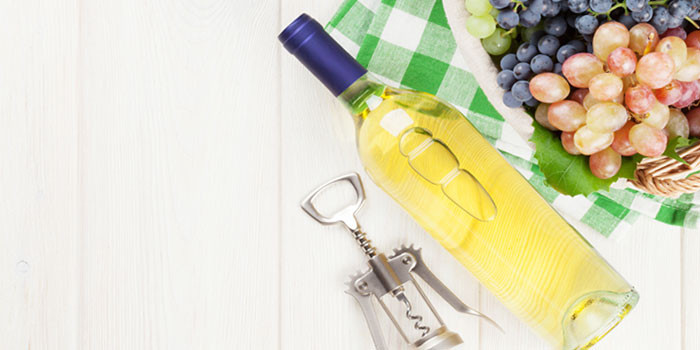Melissa Odabash
- 44 207 499 9129
- email us
- London, West Sussex, United Kingdom


SPRING 2019 (Florida Coast Magazine) – When we think of a white Bordeaux, how much do we really know about the forgotten sister of the hunky, full bodied red? It turns out, not as much as we thought.
Once upon a grape, the white Bordeaux was just as popular as the red, if not more so. Then a small hiccup of arrogance or dare one say idiocy occurred, where many decided to follow the crowd with what a “good” wine really is.
Bordeaux loosely translates as “along the waters,” or the rivers of Garonne and Dordogne to be exact. Many believe that depending on which side of the river the grapes are grown produces the better wine, when in actuality a quality white Bordeaux relies more on the quality of soil, harvest, and the technique of combining grapes. Once the individual wines have come of age, the cellar master and oenologist have fate on their taste buds. They are the ones who decide which wines will be blended and the percentage to be mixed, with the ultimate goal of producing a good quality wine.
It has been suggested the Romans created the wine we now know as Bordeaux. A lot of credit is due for their many great discoveries, but this was not one of them. Bordeaux wine has been floating up and down the Garonne river way before the Romans ever set foot on French soil. The Romans did however sophisticate and cultivate the land in order to produce a better crop and therefore a more refined wine. Throughout history, Bordeaux has had its peaks and falls. For example, after wine crops were destroyed during the devastating frost of 1956, the white Bordeaux was shamed for being over priced and consumption took a dip. It was still, however, the dominant color and harvest until the late 1960s where its popularity peaked. The 1970s favor shifted to the red and quickly left the white in its wake.
A large majority of grapes used in white Bordeaux are Sauvignon Blanc and Sémillona. Muscadelle, Ugni Blanc, and the Colombard grapes may also appear, though they are not as common. Sauvignon is the most common of grapes used for white wine production in France. This particular grape thrives in Bordeaux’s mild winters and warm summers, resulting in a successful harvest. Experts have had numerous arguments as to whether the Sauvignon grape originated in Bordeaux or the Loire region. Passions can run high when the conversations turn to the grape, but all experts agree on one thing: the Sauvignon formed the white Bordeaux.
The early millennium years saw white Bordeaux hold a 9% market share in the world of wine production. This averages at roughly 7 million bottles of white Bordeaux bottles being produced each year, yet it is still hard to find a variety of white Bordeaux in many wine bars and restaurants. The year 2005 produced some of the best white Bordeaux this millennium. Could this simply be a lack of knowledge that the white Bordeaux is out there and much of it is damned good, or is it merely the fact the average wine consumer has not been exposed to the fresh dynamics of this wine?
When looking for a white Bordeaux, remember the ratio of grapes—the higher the Sémillon content, the greater potential to store longer. Let’s keep things simple. White Bordeaux is a light white that if harvested in the correct manner, can produce some very complex undertones. Grape blending is a serious business when it comes to this particular wine. Think of a grape on grape love making ritual with the goal being a procreation of a perfect blend. This results in happy wineries and satisfied consumers.
Not only can these blends be magically seductive, they are a virtuosity, a craft, and they can often provide a great bang for your buck. So when you order your usual Sauvignon Blanc or Chardonnay, stop! Be just a tad daring and order a white Bordeaux. You maybe surprised and seduced into loving this shy and unassuming wine.
Florida Coast Magazine Staff Favorite:
// Vintage: 2016
// Grape Variety: 51.3% Sémillon, 47% Sauvignon, 1.7% Muscadelle
// Price: $21.96
Floridene is the combination of the founders’ names, Florence and her husband Denis Dubourdieu. Founder Denis is not only a white wine expert, he is also a Professor and Director of Oenology at the University of Bordeaux. This white Bordeaux is dry and complex in flavor and dimension with floral aromas, and a suggestion of lemon. Clos Floridene Blanc, is also influenced by a mineral base, meaning that it is not entirely shaped by fruit, spices, or herb. This particular wine is heavily swayed by the soil in which the vine is grown. A thin layer of clay sand covers the limestone sub soil of the Pujols Sur Ciron and this is what adds a certain depth.
These flavors mingle perfectly while frolicking on a bed of wild flowers. Don’t expect the rich aroma of a chardonnay or the oaky fullness it provides. Instead appreciate the delicate suggestions, Cinderella-like in its beauty, but overshadowed by its loud-mouth relatives.
Available at: www.astorwines.com